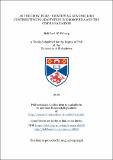Files in this item
As the crow, flies : identifying genomic loci contributing to adaptation in Drosophila and the corvid radiation
Item metadata
| dc.contributor.advisor | Ritchie, Michael G. | |
| dc.contributor.author | Wiberg, R. Axel W. | |
| dc.coverage.spatial | iv, 262 p. | en_US |
| dc.date.accessioned | 2019-11-07T09:22:21Z | |
| dc.date.available | 2019-11-07T09:22:21Z | |
| dc.date.issued | 2019-06-27 | |
| dc.identifier.uri | https://hdl.handle.net/10023/18868 | |
| dc.description.abstract | Identifying loci that contribute to adaptive traits is an important goal of evolutionary biology. I take a comparative genomic approach to identify loci that have responded to divergent selection. First I consider the challenges of identifying consistent genomic responses to selection during experimental evolution. I use population genetic simulations to show that commonly applied statistical tests perform poorly and identify superior methods. These will also be useful in comparing allele frequencies in other contexts. Next I analyse whole genome data from an experimental evolution study of Drosophila pseudoobscura evolving under altered mating systems. I find that around 300 SNPs show consistent allele frequency differences between experimental treatments. These are clustered in genomic regions which also show signatures of selective sweeps or background selection. These regions contain genes with mutant phenotypes related to changes already documented in this system. In another chapter I use a novel approach to identify markers potentially influencing female re-mating rate among lines of D. pseudoobscura. I use simulations to show that there are more fixed differences between extreme pairs of isofemale lines from different populations than expected by chance. Many of the genes are implicated in female mating behaviour in other studies. I then focus on local adaptation in wild Drosophila montana populations. I use Bayesian methods to relate genetic and environmental differentiation among populations. Finally, I take a broader comparative approach using multiple genomes from 14 species of crow to identify potential signatures of selection in the New Caledonian (NC) (Corvus moneduloides) and Hawai’ian crow (Corvus hawaiiensis) lineages. The NC and, more recently, Hawai’ian crows are of great interest for their unusual tool-using foraging behaviour. I find only modest evidence for greater rates of molecular evolution at coding regions within these lineages. This thesis applies novel techniques to genomic data to identify candidate loci for evolutionary divergence in these different systems and highlight analytical methods that will be generally useful in other systems. | en_US |
| dc.language.iso | en | en_US |
| dc.publisher | University of St Andrews | |
| dc.title | As the crow, flies : identifying genomic loci contributing to adaptation in Drosophila and the corvid radiation | en_US |
| dc.type | Thesis | en_US |
| dc.type.qualificationlevel | Doctoral | en_US |
| dc.type.qualificationname | PhD Doctor of Philosophy | en_US |
| dc.publisher.institution | The University of St Andrews | en_US |
| dc.identifier.doi | https://doi.org/10.17630/10023-18868 |
This item appears in the following Collection(s)
Items in the St Andrews Research Repository are protected by copyright, with all rights reserved, unless otherwise indicated.

